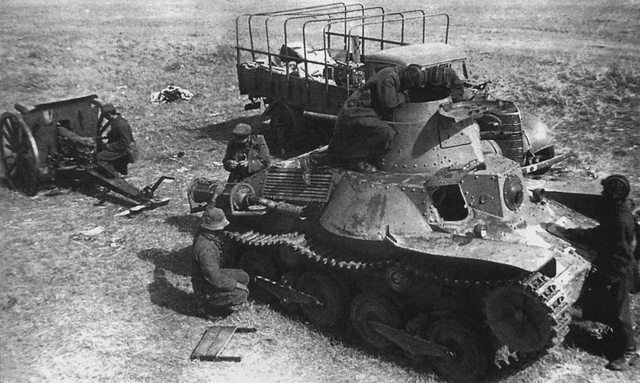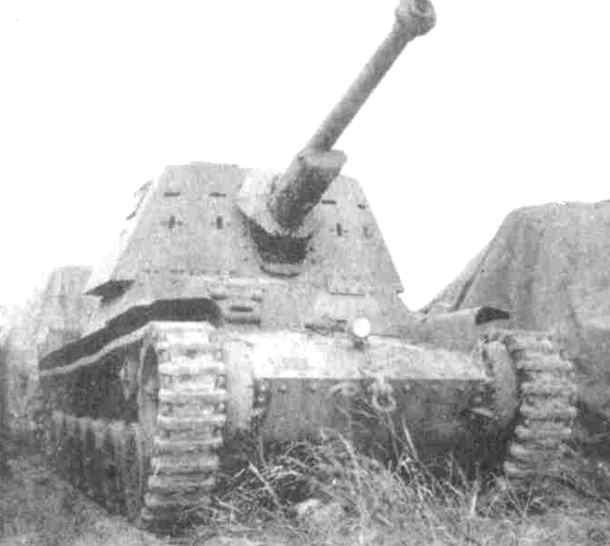明斯克卫星计划:日系TD计划浮出水面
17173 新闻导语
明斯克卫星计划:日系TD计划浮出水面
This is Part 1 of the Japanese **** Destroyer Series, dealing with the origins of **** destroyer development and the first results. Before we look into the beginnings of the pretty meager collection of Japanese **** destroyers, we need to first understand how **** destroyers came about.
The first **** destroyers were basically stopgap solutions, mounting an anti-**** gun on a tracked vehicle and calling it a dedicated anti-**** weapon. The German Panzerjägers, anti-**** guns in an open-topped superstructure on a light **** chassis, were the major starting point for this idea. The existence of heavy French ****s like the Char B1, which were beyond the capabilities of the major anti-**** guns in service, meant that the Germans needed larger guns on mobile platforms. That is how Panzerjäger I and the Marder series came about: putting larger anti-**** guns on **** chassis to give them the mobility to keep up with the rest of the armored forces. It was only as the war went on that with more powerful ****s coming to the battlefield that we have the appearances of casemates on medium/heavy **** chassis armed with powerful guns.
Now, considering this background, one has to put onself into the mindset of the Imperial Japanese Army to understand why Japan was never too keen on developing **** destroyers. When your current enemy barely has any armor to speak off, and you have a non-aggression treaty with potential enemy to the north (which you fought before, and realized that your current towed anti-**** guns were adequate for the job), why would you go through the trouble of trying to stick larger guns on your already limited **** chassis? After all, your 37 mm Anti-**** Gun Type 94 could just about deal with anything in your path, including those Western powers in Southeast Asia with their Universal Carriers, Lanchester Armoured Cars, Carden Loyd ****ette, and Stuarts. Your industrial capacity is already strained to the breaking point with a massive continental war. So, why bother with this **** destroyer nonsense?
Obviously, when yo***ealize that perhaps one or two of those enemies might be bringing something more protected.
这是本子TD线第一部分,处理了TD的起源和(得出)第一个结论。在我们深入研究这些相当稀少的TD搜集资料之前,我们要搞清楚TD怎样产生的。第一个TD基本上就是个应急措施,在履带车上安装了反坦克炮,并把它叫做反坦克武器。
第一个TD基本上就是个应急措施,在履带车上安装了反坦克炮,并把它叫做专用反坦克武器。德国猎人坦克(一突?后文有提到1突,我百度了一下,第一个坦歼的车体是1号坦克,jägers德语是猎人,追猎者就是Pirschjäger),反坦克炮安装在轻坦壳体的上面敞篷部分,这是这个想法的初次尝试。因为法国人拥有一些重型坦克比如B1,超越了当时在役的主流反坦克炮的能力,这意味着德国人需要在移动平台安装更大(口径)的火炮。这就是1突和黄鼠狼系列怎么出现的:将更大的反坦克炮安装在坦克底盘上,使其具有机动性,跟上装甲部队的其余部分。随着战争进程,只有当更牛逼的坦克出现在战场上时,我们才能看到基于中型/重型坦克的TD出现。考虑到这一背景,站在帝国陆军的立场上,你就会知道为啥日本不热衷于坦歼了。如果你眼前的敌人几乎没有任何的装甲可讲,而且,在北方你还有一个签过了互不侵犯条约的潜在敌人(通过之前的交火,你发现现有的拖曳式反坦克炮足够对付他们了),你为啥还要挑战在有限的车体上安装更大的炮的难题呢?毕竟,你的37毫米反坦克炮***可以解决你道路上所有的事情,也包括英美鬼畜部署在东南亚的通用载具、兰彻斯特装甲车、卡登洛伊德小坦克和斯图亚特。因为深陷**战争,你的工业能力已经捉襟见肘到濒临崩溃。所以,你为啥还在坦歼的废话上烦恼呢?
很显然,当你意识到也许一两个敌人也可能会带来更多的东西防御。

Contrary to what many think today, Japan did learn quite a few lessons in the clashes with the Soviet Union. These were consolidated into Nomonhan Research Report, a classified candid document not meant for public consumption, but intended for the use of staff officers who would be charged with implementing the recommendations. Of course, most of the suggestions were ultimately not implemented as it should have been, due to the core lack of industrial capacity Japan was facing during its entire time as an empire. Regardle***y, the document did have great influence over Japanese armor development, and would be the background for the making of the Japanese **** destroyer force.
和很多人现在认为的相反,日本确实在与苏联的冲突得到了到不少教训。这些被合并为诺门罕研究报告,一份****坦诚不对大众舆论开放,但给负责执行建议的参谋人员使用。当然,大部分的建议,并没有按期望值实现,由于在他整个作为帝国的时间内,日本面临的核心工业能力的缺乏。无论如何,该文件确实对日本装甲的发展有很大影响,并且成了为日本坦歼生产的背景。

Perhaps the silent complaint noted in the report was the lack of sufficient anti-**** weapons, be it the towed guns or ****s. In fact, one part noted that the troops would be annihilated without such weapons in case of a future attack, and endorsed research to design a more powerful anti-**** gun that would be necessary to defeat heavier armor likely to appear in the future. This lead directly to the development of the 47 mm Anti-**** Gun Type 1 and its adaptation for use in Type 97 Chi-Ha Kai.
也许在报告中标注出的无声抱怨是缺乏足够的反坦克武器了,或是牵引火炮或坦克。事实上,一部分指出缺乏这类防止未来攻击的武器,部队可能全军覆没,并通过研究以设计出更强大的反坦克炮,它必须有能力打败可能出现在未来的重装甲。这直接导致47毫米反坦克炮1式和其适用的97式中战的发展。
The findings in the Nomonhan Research Report also endorsed the concept of making the anti-**** weapon the nucleus of the infantry formation, along with with suggestions for the need for a self-propelled gun as part of a comprehensive renovation of artillery. While ultimately the organic artillery of Japanese infantry divisions became so bewildering as to defy the notion of standardization, self-propelled guns did begin to appear in Japanese units. The first one, born from the fire of the Mongolian plain, was Type 1 Ho-Ni I.
诺门坎的研究报告提出一个观点:把反坦克武器作为步兵编队的核心,这个报告还建议在炮兵的全面革新中,引入自行火炮。 日本步兵师的步兵编队如此出乎意外,违背了标准化的概念,自行火炮开始出现在日本部队。第一辆是一式Ho-Ni I,来自蒙古平原的战火(忽必烈的时代么)。

Type 1 Ho-Ni I was developed by using the existing Chi-Ha chassis and engine, and replacing the gun turret with an open casemate with frontal and side armor only, while applying extra armor to the front hull. Basically, it followed the Panzerjäger idea, sticking a larger gun onto an existing **** chassis. In line with the need for both a good anti-**** weapon and self-propelled gun, Ho-Ni I was designed to operate as self-propelled artillery in the armored divisions while being armed with a relatively high-velocity gun for anti-**** purposes.
1式Ho-Ni I是利用现有的Chi-Ha底盘和发动机发展而来,并用正面只有正面和侧面装甲敞篷炮塔替换,同时应用额外的装甲前车体。基本上,它沿袭了Panzerjäger(1突)理念,将一个更大的炮装到现有坦克的底盘。根据兼具良好的反坦克武器和自行火炮的需要,Ho-Ni I在步兵师看来是设计用作自行火炮的,同时具有了一个相对高速炮的反坦克目的。
One might ask why it took almost two year (development started in December 1939 and acceptance was in October 1941) for such a simple vehicle to come out. As it turns out, clashes about the purpose of this “gun-**** (housensha)” was the main reason for the delayed development. At least there was the simple lack of any suitable anti-**** gun until 47 mm Anti-**** Gun Type 1 came along. Aside from this, there was the disagreement on whether this gun-**** should be purposed for anti-**** or artillery purposes. The anti-****/artillery argument was only settled after the decision to make a separate self-propelled gun armed with a 10.5 cm howitzer (Ho-Ni II) for pure artillery purposes, with Ho-Ni I providing both long-range direct fire and anti-**** capabilities with a modified 75 mm Field Gun Type 90.
有人会问为啥他花了两年才制造出这个坦克呢?事实证明,和“gun-**** (housensha)”的冲突是主要发展延迟的原因。至少缺乏一些合适的反坦克炮,直到47毫米反坦克炮1型出现。除了这个,还有gun-****是否应定意为反坦克炮或火炮的分歧。自决定制造一个独立的装备10.5厘米榴弹炮的自行火炮作为纯火炮后,该反坦克炮/火炮的参数进行单独设置,Ho-Ni I同时提供远距离直接瞄准射击和装备改良的75毫米野战炮的90式炮的反坦克能力。
Ho-Ni I served mostly with the 2nd Armored Division in the Philippines, where while it did not have a big impact on the battlefield, was still able to do its job sufficiently for such an outdated design. It was one of the few vehicles that could defeat a Sherman, with the veterans of the Japanese-Soviet conflicts carrying out camouflage and ambushes, managing to destroy M4 ****s from around 500 meters away. In the end, all Ho-Ni Is were destroyed, with only one example surviving in the United States.
Ho-Ni I大多与第2装甲师在菲律宾服役,虽然在那里战场上没有有很大的影响,但是这种过时的设计依然能充分完成其工作。这是为数不多的可以打败谢尔曼的车辆,日本和苏联冲突的退伍军人执行伪装和伏击,设法从大约500米开外摧毁M4坦克。最终,所有的Ho-Ni I被摧毁,只有一例存货在美国。

For the Imperial Japanese Army, however, Ho-Ni I was not enough. In order to solve the issues of crew survivability, a fully enclosed and armored casemate was made for the upgrade, Ho-Ni III, in 1943. In addition to this, with the case mate having its flanks protruding beyond the hull sides, it provided more room for the crew and the possibility of upgunning, although such upgunning never happened due to lack of resources. Also, the gun was changed to 7.5 cm **** Gun Type 3 Model II, a modified version of 7.5 cm Field Gun Type 90 for use in gun carriers. The breech was shorted by 300 mm to allow greater traverse (22° to each side) and elevation (-15°/+25°).
但是,对于****陆军来说,Ho-Ni I是不够的。为了解决乘员生存的问题,升级为全封闭和装甲的炮塔,也就是Ho-Ni III,产于1943年。除了这一点,在同样的情况下它车体两侧侧面突出来,他为成员和火炮升级改造提供了更多的空间,虽然这种改造因为资源不足从来没搞过。此外,火炮改为7.5厘米坦克炮3式II型,火炮载体上装备一个改良版7.5cm野战炮90式。菊花缩减300毫米来容许更大的水平射界(22°至每边)和俯仰角(-15°/+25°)。

Unfortunately, unlike Ho-Ni I, Ho-Ni III was kept on the Home Islands for the “Decisive Battle” against the Allied invasion, thus never being used in actual combat.
不幸的是,不像Ho-Ni I,为了对盟军的决战,Ho-Ni III是继续留在本土群岛,从而从未在实战中被应用。
This was just the beginning of Japanese **** destroyer development. While the beginnings were humble, the start of the Pacific War meant that Japan needed more powerful vehicles, and thus began rapid improvements…..
这是日本的坦克歼击车的发展的开端。虽然开始很卑微,但是太平洋战争的开始意味着日本需要更强大的车辆,并由此开始了迅速改善.....
This entry was posted inUncategorizedbySilentstalker. Bookmark thepermalink.
关于的新闻
- (2025-11-27) 谁没收了它的175毫米主炮?
- (2025-11-27) 咸鱼翻身还是强者恒强?曾经的弱势坦克如今强度如何?
- (2025-11-24) 3连发重炮+大俯角铁头的它,新版本已经低调回归强者之位!
- (2025-11-24) 三环均伤排名第一的含金量!6个轮子的高机动狙击手无需多言
- (2025-11-24) 【超测前瞻】双发配火箭,强度要上天








